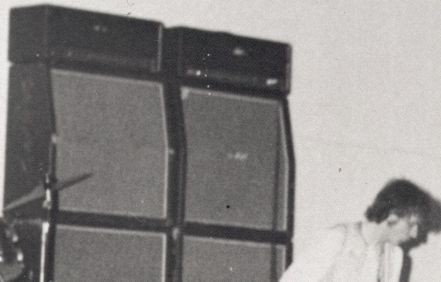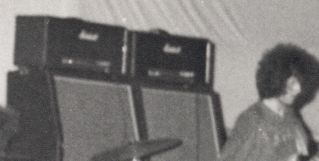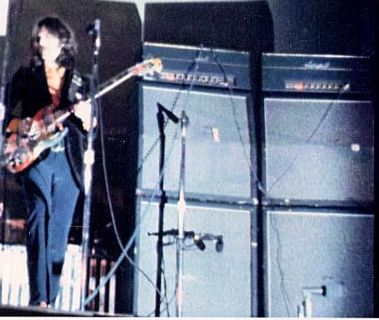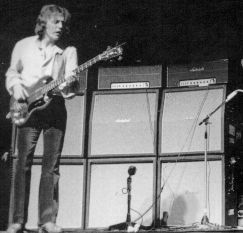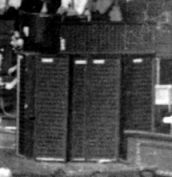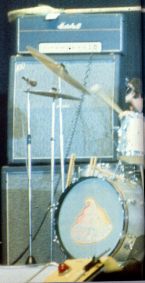
Guitars
Initial 1966: Jack and Eric – Probably their existing rigs which for Eric was the Marshall 1962 45 Watt Combo with 2x12. Jack's was probably a Vox T45 or a Marshall 1962. Once they started serious rehearsals they moved to:
1966: Jack & Eric, each – Marshall 1959 100 watt Plexipanelled Superlead Amplifiers (3 switch), 1 1960 75 watt 4x12 Angle Front Cabinet + 1 1960B 75 Watt 4x12 Flat Front Cabinet (extra tall version which is some 6" taller). PA System was a pre-production 200Watt model housed in an enlarged Super P.A cabinet with 2 4x12 1969 Column Speaker cabinets.
Late '66: Eric – Amp as above but 1 1982 100 watt 4x12 Angle Front Cabinet + 1 1982B 100w Flat Front 4x12 cabinet (extra tall version) (left - note: flat cab lying on its side). Some photographs show Jack or Eric with a '2' switch Super Lead and Jack with two angles or two flat cabs so I assume they had purchased an extra amp and stack as a spare ( a mere 280gns, 304 pds, $US1,000 in 1966 money which would be equivalent to, at the very least, $US10,000 today!!!).
Feb '67: Eric moves to two Marshall 1959 100 watt Plexipanelled Superlead Amplifiers (3 switch), and two stacks comprising 1960 75 watt 4x12 Angle Front Cabinet + 1 1960B 75 Watt 4x12 Flat Front Cabinet (extra tall version). Jack also adopts two stacks but uses a custom 200 Watt Marshall (1967 or 1978) Major and has his 100W as spare. Note: around this time John Entwhistle also moved to 200Watt Majors.
By the time of the US tour they had accumulated extra amps as spares. Jack now has two 200W Marshall Majors and uses the 200W PA in emergencies.
FILLMORE 67:
Note the extra deep cabinet of the 200W Marshall Majors (1967 or 1978)
with Jack plugged into the right amp and the left not even on. These are unique
amps - cabinets of 200 Watt Super PA's with Superlead panel layout.
The thinner cabinet of the 1959 Superlead, Y cable, both on1968 US Tour: as above but cabs 1982 100w models including standard size 1982B ( angles and flats the same height). Due to the demands of touring the States they purchased a second set of gear on the East Coast. But this involved only 100Watt amps for Jack so he moved to using two.
Winterland Soundcheck - plugged into one 200 Watt Marshall 1967 (or 1978).
These are now production models
Being Recorded on March 7 1968 at the Fillmore
Note the cable arrangements and the Y splitter.
It seems EC unplugged from the WahWah and plugged in the Y cable or they had
some sort of switching circuit on top of the amp (controlled by the roady?)Late 1968 on the farewell tour – Jack uses two 100W Marshall amps. Two of these would be louder than the single Marshall Major thus the relative increase in bass presence on the final tour. At the Farewell concert Jack has added a 'bass' stack comprising a Marshall 1992 100 Watt Plexipanelled Superbass Amplifier (2 switch), 1 1935 75w Angle Front cab + 1 1935B 75w flat cab but one stack is not interconnected and is clearly just the spare. Also, at the Farewell Concert, one of Eric's amps is an 8 knob tremelo 1959T Superlead (Pete's preferred model).
DID EC USE BOTH STACKS?
